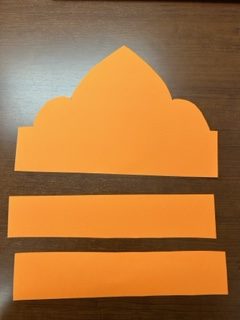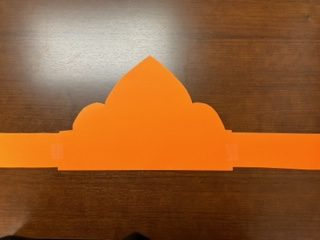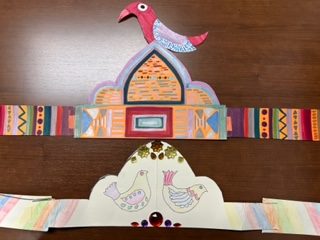Yoruba: Create a Royal Crown
For centuries the Yoruba people have shared a common language and culture but have never been a single united group. It is believed they migrated from Central Africa to their present locations in West Africa over a thousand years ago. The Yoruba established numerous kingdoms, which were centered around a capital city or town and were each ruled by a king or oba. These towns have become modern-day cities that are spread over Nigeria, Benin, Togo, and Ghana.
Traditionally, a king was both the spiritual and political leader of a kingdom with supreme authority. He ruled by divine right and was considered a sacred being. Today, Yoruba kings have no political power. They are figure heads and serve in ceremonial roles.
Crowns

Yoruba crowns from the Lam Museum collection
A Yoruba crown is a king’s symbol of power and status. Modern Yoruba kings usually have several different beaded crowns and caps which are worn on state occasions and during public functions.
Yoruba crowns are called ade or adenla. They are cone-shaped, with features and designs that are built up, then the entire surface is covered with brightly colored beads. Elaborate glass beading is a sign of royalty. They emphasize the wealth and status of a king. Each bead color represents a different Yoruba god. Since the king is protected by all the gods, the colors symbolize his divinity.
Ade refers to any royal cap or beaded headpiece, even some crowns. The images on these may express a king’s personal interests or taste.
A great crown with a beaded veil is called an adenla. Each part of an adenla has a purpose, and every motif symbolizes kingship. The veil on a crown protects people from the king’s powerful gaze and signals his connection to the gods. Stylized faces are a way to remember a royal line, honor ancestors, and represent ancestral kings or Yoruba gods. Birds represent a king’s ability to mediate between spiritual and secular worlds, but also allude to the powers of women. Triangles and diamond shapes reflect a crown’s sacred qualities. Interlace patterns refer to the continuity and balance of life. An elephant is a symbol of longevity and power. Many of these traditional designs are still being used to create modern adenlas. However, it is important to remember that the meanings and motifs on a crown can vary among the Yoruba.
Let’s Create a Royal Crown!
Each Yoruba crown is unique because the maker of a crown chooses colors, designs, and images that tell something about the king who wears it. As you decorate your crown use colors and designs that tell something about you. Have fun making your own royal crown!
You Will Need:
• Crown template
• Bird template
• Cardstock
• Scissors
• Pencil
• Tape
• Glue
• Crayons, colored pencils, or markers
• Optional: beads, stickers, jewels, ribbons, flowers, pictures from magazines or off the internet
Instructions:
- Print crown and bird templates.
- Cut out the crown template.
- Using the crown template draw the shape on cardstock. You can also draw your own crown shape if you want.
- Cut out the crown shape.
- Cut 2 long stripes from the cardstock for the arms of your crown.

- Tape or glue 1 strip to each side of your crown. Cut these as long as you need to fit your head.
- Using crayons, colored pencils, or markers color the base of your crown with different patterns and shapes.

- Continue decorating your crown by drawing faces or other designs on your crown, gluing pictures on your crown, coloring birds, cutting them out and gluing them to your crown, attaching jewels, stickers, beads, ribbons, or flowers to your crown.
- When you finish decorating tape the arms together to fit your head so it slides on and off.
